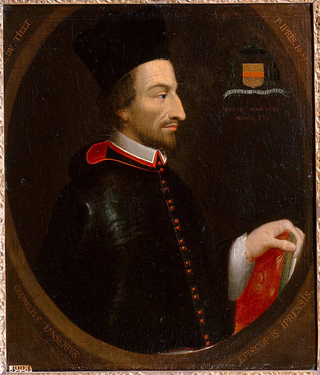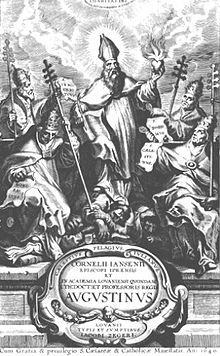
Cornelius Jansen was the Dutch Catholic bishop of Ypres in Flanders and the father of a theological movement known as Jansenism.

Augustinus seu doctrina Sancti Augustini de humanae naturae sanitate, aegritudine, medicina adversus Pelagianos et Massilianses, known by its short title Augustinus, is a theological work in Latin by Cornelius Jansen. Published posthumously in Louvain by Jacobus Zegers in 1640, it was in three parts:
- On Pelagianism
- On original sin
- On divine grace
The formulary controversy was a 17th- and 18th-century Jansenist refusal to confirm the Formula of Submission for the Jansenists on the part of a group of Catholic ecclesiastical personnel and teachers who did not accept the charge that their beliefs about the nature of man and grace were heretical as the Holy See declared. In the Kingdom of France, it pitted Jansenists against Jesuits. It gave rise to French theologian Blaise Pascal's Lettres provinciales, the condemnation of casuistry by the Holy See, and the dissolution of organised Jansenism.
Zeger Bernhard van Espen (Espenius) was a Belgian canonist, who supported Gallican theories and was an ardent upholder of secular power against religious authority. Van Espen is generally classed among the ablest writers on ecclesiastical law.

Arnold Vinnius was one of the leading jurists of the 17th century in the Netherlands.

The Old University of Leuven is the name historians give to the university, or studium generale, founded in Leuven, Brabant, in 1425. The university was closed in 1797, a week after the cession to the French Republic of the Austrian Netherlands and the principality of Liège by the Treaty of Campo Formio.
Nicolaus Vernulaeus (1583–1649) was a professor at the University of Leuven and an important Neo-Latin playwright.

Diodorus Tuldenus, born Theodoor van Tulden was regius professor of Civil Law at the University of Leuven.
De Alchemia is an early collection of alchemical writings first published by Johannes Petreius in Nuremberg in 1541. A second edition was published in Frankfurt in 1550 by the printer Cyriacus Jacobus.
Lucien or Lucianus Ceyssens OFM (1902–2001) was a twentieth-century ecclesiastical historian who specialised in the history of Jansenism.
Gerard van Rivieren, Latinized Gerardus Rivius was a printer in the Southern Netherlands. He was the publisher of Martin Delrio's famous witchcraft treatise Disquistiones Magicae and was at one time suspected of having printed Corona Regia, a satire on James I of England that caused diplomatic ructions. His printer's mark was a winged horse, and his motto "Totum sic irrigat orbem".

Guiliam or Willem Lesteens (1590–1661), Latinized Gulielmus Lesteenius, was a printer and publisher in the city of Antwerp, in the Spanish Netherlands.
Jacobus Jansenius, alternatively Jansonius or Janssoon (1547–1625) was a Dutch theologian who served as rector of Leuven University.

Jan Maes or Joannes Masius was a printer and bookseller in the university town of Leuven in the Habsburg Netherlands.

Jacob Bathen or Jacob Baethen, Latinised as Jacobus Bathius, Iacobus Batius and Jacobus Bathenius, was a Flemish bookseller, printer and publisher of the 16th century, mainly known now for music publications. He is sometimes confused with Johannes Baethen, a printer active in Leuven and Cologne between 1552 and 1562, who was likely his brother. Jacob was active in Leuven, Maastricht and Düsseldorf. He is mainly remembered for his publication of the so-called Maastricht songbook of 1554, which is one of only five surviving song books in the Dutch language from the 16th century.
Nicolaes Breyghel, Latinized Nicolaus Breyghelius, was a leading printer and bookseller in 17th-century Bruges in the Habsburg Netherlands. He was the first publisher of a weekly newspaper in the city.
Martinus Nutius or Martin Nuyts was the name of three successive printer-booksellers in 16th and 17th-century Antwerp. Collectively, they were active from 1540 to 1638.
Events in the year 1631 in the Spanish Netherlands and Prince-bishopric of Liège.

Johannes Wiggers (1571–1639) was a theologian from the Duchy of Brabant in the Habsburg Netherlands.









